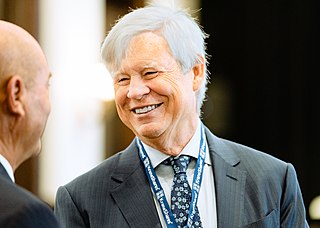Related Research Articles
Finance is the study and discipline of money, currency and capital assets. It is related to, but not synonymous with economics, which is the study of production, distribution, and consumption of goods and services; the discipline of financial economics bridges the two. Financial activities take place in financial systems at various scopes; thus, the field can be roughly divided into personal, corporate, and public finance.
Financial economics is the branch of economics characterized by a "concentration on monetary activities", in which "money of one type or another is likely to appear on both sides of a trade". Its concern is thus the interrelation of financial variables, such as share prices, interest rates and exchange rates, as opposed to those concerning the real economy. It has two main areas of focus: asset pricing and corporate finance; the first being the perspective of providers of capital, i.e. investors, and the second of users of capital. It thus provides the theoretical underpinning for much of finance.
Market risk is the risk of losses in positions arising from movements in market variables like prices and volatility. There is no unique classification as each classification may refer to different aspects of market risk. Nevertheless, the most commonly used types of market risk are:

Robert Fry Engle III is an American economist and statistician. He won the 2003 Nobel Memorial Prize in Economic Sciences, sharing the award with Clive Granger, "for methods of analyzing economic time series with time-varying volatility (ARCH)".
In finance, volatility clustering refers to the observation, first noted by Mandelbrot (1963), that "large changes tend to be followed by large changes, of either sign, and small changes tend to be followed by small changes." A quantitative manifestation of this fact is that, while returns themselves are uncorrelated, absolute returns or their squares display a positive, significant and slowly decaying autocorrelation function: corr(|rt|, |rt+τ |) > 0 for τ ranging from a few minutes to several weeks. This empirical property has been documented in the 90's by Granger and Ding (1993) and Ding and Granger (1996) among others; see also. Some studies point further to long-range dependence in volatility time series, see Ding, Granger and Engle (1993) and Barndorff-Nielsen and Shephard.
Financial econometrics is the application of statistical methods to financial market data. Financial econometrics is a branch of financial economics, in the field of economics. Areas of study include capital markets, financial institutions, corporate finance and corporate governance. Topics often revolve around asset valuation of individual stocks, bonds, derivatives, currencies and other financial instruments.
Financial modeling is the task of building an abstract representation of a real world financial situation. This is a mathematical model designed to represent the performance of a financial asset or portfolio of a business, project, or any other investment.
The following outline is provided as an overview of and topical guide to finance:
Statistical finance, is the application of econophysics to financial markets. Instead of the normative roots of finance, it uses a positivist framework. It includes exemplars from statistical physics with an emphasis on emergent or collective properties of financial markets. Empirically observed stylized facts are the starting point for this approach to understanding financial markets.
In finance, the Chen model is a mathematical model describing the evolution of interest rates. It is a type of "three-factor model" as it describes interest rate movements as driven by three sources of market risk. It was the first stochastic mean and stochastic volatility model and it was published in 1994 by Lin Chen, economist, theoretical physicist and former lecturer/professor at Beijing Institute of Technology, American University of Beirut, Yonsei University of Korea, and SunYetSan University.

In finance, volatility is the degree of variation of a trading price series over time, usually measured by the standard deviation of logarithmic returns.
In financial econometrics, the Markov-switching multifractal (MSM) is a model of asset returns developed by Laurent E. Calvet and Adlai J. Fisher that incorporates stochastic volatility components of heterogeneous durations. MSM captures the outliers, log-memory-like volatility persistence and power variation of financial returns. In currency and equity series, MSM compares favorably with standard volatility models such as GARCH(1,1) and FIGARCH both in- and out-of-sample. MSM is used by practitioners in the financial industry to forecast volatility, compute value-at-risk, and price derivatives.
Quantitative analysis is the use of mathematical and statistical methods in finance and investment management. Those working in the field are quantitative analysts (quants). Quants tend to specialize in specific areas which may include derivative structuring or pricing, risk management, investment management and other related finance occupations. The occupation is similar to those in industrial mathematics in other industries. The process usually consists of searching vast databases for patterns, such as correlations among liquid assets or price-movement patterns.
In mathematical finance, the CEV or constant elasticity of variance model is a stochastic volatility model that attempts to capture stochastic volatility and the leverage effect. The model is widely used by practitioners in the financial industry, especially for modelling equities and commodities. It was developed by John Cox in 1975.
Mathematical finance, also known as quantitative finance and financial mathematics, is a field of applied mathematics, concerned with mathematical modeling of financial markets.

Philippus Henricus Benedictus Franciscus "Philip Hans" Franses is a Dutch economist and Professor of Applied Econometrics and Marketing Research at the Erasmus University Rotterdam, and dean of the Erasmus School of Economics, especially known for his 1998 work on "Nonlinear Time Series Models in Empirical Finance."
Chris Brooks is Professor of Finance in the School of Accounting and Finance at the University of Bristol, United Kingdom.

Svetlozar (Zari) Todorov Rachev is a professor at Texas Tech University who works in the field of mathematical finance, probability theory, and statistics. He is known for his work in probability metrics, derivative pricing, financial risk modeling, and econometrics. In the practice of risk management, he is the originator of the methodology behind the flagship product of FinAnalytica.

Antonio Mele is an Italian economist.

Dilip B. Madan is an American financial economist, mathematician, academic, and author. He is Professor Emeritus of Finance at the University of Maryland.
References
- 1 2 3 4 5 6 7 8 9 10 11 12 13 14 15 16 "CV, Stephen J Taylor" (PDF). Retrieved 17 December 2018.
- ↑ "Stephen J Taylor – Google Scholar Citations" . Retrieved 17 December 2018.
- ↑ "Stephen J Taylor, Lancaster University" . Retrieved 17 December 2018.
- ↑ Taylor, Stephen J. (2007). Modelling Financial Time Series. doi:10.1142/6578. ISBN 978-981-277-084-4.
- ↑ A Reappraisal of the Efficiency of Financial Markets . Retrieved 17 December 2018.
- ↑ Taylor, Stephen J. (2 September 2007). Asset Price Dynamics, Volatility, and Prediction (eBook and Paperback). Princeton University Press. ISBN 9780691134796 . Retrieved 17 December 2018.
